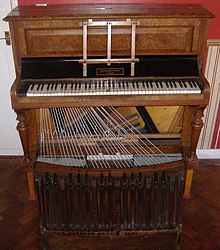
Back Piano amb pedals Catalan Pedálový klavír Czech Pedalklavier German Piano con pedales Spanish Piano-pédalier French Pianoforte a pedali Italian ペダルピアノ Japanese Педальное фортепиано Russian Педальне фортепіано Ukrainian


The pedal piano (or piano-pédalier[1] or pédalier,[2]) is a kind of piano that includes a pedalboard, enabling bass register notes to be played with the feet, as is standard on the organ.[3]
There are two broad types of pedal pianos: either the pedal board may be an integral part of the instrument, using the same strings and mechanism as the manual keyboard (e.g. the 19th century Érard pedal grand piano and Pleyel upright pedal piano), or[4] it may consist of two independent pianos (each with its separate mechanics and strings) which are placed one above the other, either a regular piano played by the hands and a bass-register piano played by the feet (e.g. the 18th century pedal piano owned by Wolfgang Amadeus Mozart and the 21st century Doppio Borgato made by Luigi Borgato), or two standard pianos of which the lower one is played from a pedalboard which acts on its (manual) keyboard through a special mechanism (e.g. the 21st century Pinchi Pedalpiano System).
- ^ Logue, Karl (1997). "Images notes". Logue Rhythm Productions. Retrieved 2008-01-24.
- ^ may be used in English as a short of form of piano-pédalier; in French however pédalier can only mean pedalboard
- ^ Belt, Philip (1997). The Piano. New York City: W. W. Norton & Company. p. 150. ISBN 0-393-30518-X.
- ^ this was the system used for pedal clavichords and pedal harpsichords